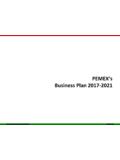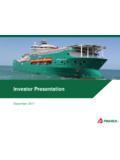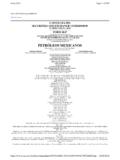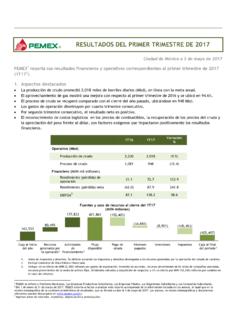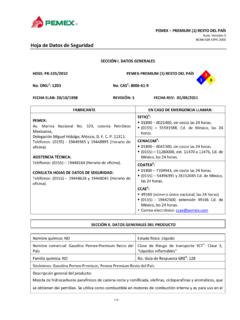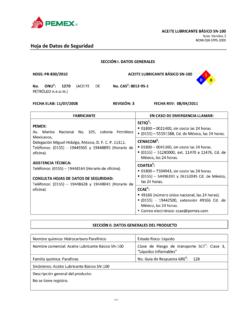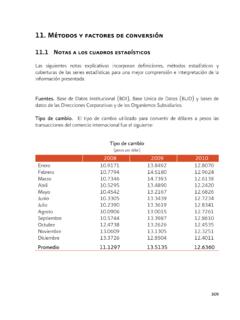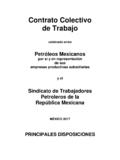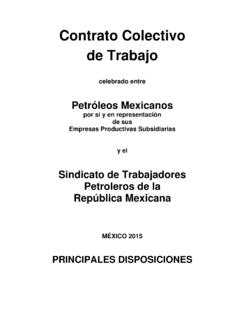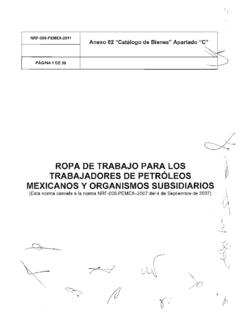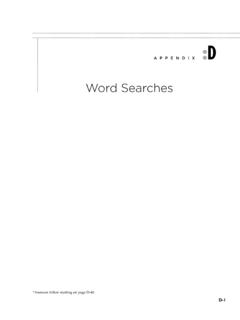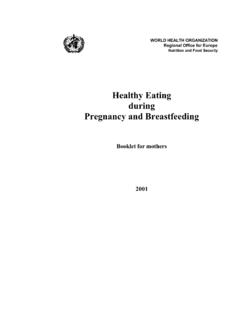Transcription of Safety Data Sheet - Pemex
1 Lineal Medium Density Polyethylene Version 7 NOM 018 STPS 2000 Safety data Sheet 1/5 SECTION I CHEMICAL PRODUCT AND COMPANY IDENTIFICATION LINEAL MEDIUM DENSITY POLYETHYLENE BDL 36050 MANUFACTURER: Pemex PETROQUIMICA EMERGENCY PHONE +52 921 211 4000 EXT. 34409 ADDRESS: Jacarandas No. 100 Colonia Rancho Alegre 1, Coatzacoalcos, Veracruz, 96558 M xico SECTION II PRODUCT INFORMATION Chemical Name Formula Commercial name CAS Number UN Number Composition (%) Polyethylene ( CH2 CH2 )n Polyethylene 25213 02 9 Not applicable + No Reportable Hazardous Substance(s) or Complex Substance(s). NOTE: The product may contain varying levels of additives such as slip and antiblocking agents, antioxidants and stabilizers.
2 SECTION III HAZARDS IDENTIFICATION This material is not considered hazardous. POTENTIAL PHYSICAL / CHEMICAL EFFECTS Material can accumulate static charges which may cause an ignition. Spilled pellets present a slipping hazard on hard surfaces. POTENTIAL HEALTH EFFECTS Material is essentially non toxic. Dust could scratch the eyes and cause minor irritation to the respiratory tract. When processed at high temperatures, the vapors/fumes given off may cause respiratory tract irritation. Molten or heated material in skin contact can cause severe burns. RISK CLASIFICATION TYPE HEALTH FLAMMABILITY REACTIVITY SPECIFIC RISK NFPA 1 1 0 HMIS 1 1 0 Lineal Medium Density Polyethylene Version 7 NOM 018 STPS 2000 Safety data Sheet 2/5 SECTION IV FIRST AID MEASURES Ingestion: No adverse effects due to ingestion are expected.
3 May be a shocking hazard. Toxicology not fully investigated. Inhalation: In case of adverse exposure to vapors and / or aerosols formed at elevated temperatures, immediately remove the affected victim from exposure. Move to fresh air. Consult a physician if irritation of respiratory passage occurs. Skin contact: For hot product: Immediately immerse in or flush affected area with large amounts of cold water to dissipate heat. Get medical attention. Eye contact: Immediately flush eyes with water for at least 15 minutes. Seek medical attention. SECTION V FIRE FIGHTING MEASURES Autoignition Temperature: 349 C Extinguishing Media: Water spray, dry chemical, carbon dioxide, or universal type foam. May re ignite itself after fire is extinguished. Special Fire Fighting Procedures: Firefighters should use standard protective equipment and in enclosed spaces, self contained breathing apparatus (SCBA).
4 Use water spray to cool fire exposed surfaces and to protect personnel. Unusual Fire and Explosion Hazards: Avoid accumulation of dust to reduce explosion potential. Fire may produce irritative gases and dense smoke. Hazardous Combustion Products: Smoke, Fume, Incomplete combustion products, oxides of carbon, flammable hydrocarbons. Flammability properties Flash Point [Method]: N/A Flammable Limits (Approximate volume % in air): LEL: N/D UEL: N/D SECTION VI ACCIDENTAL RELEASE MEASURES SPILL MANAGEMENT Land Spill: Spilled pellets present a slipping hazard on hard surfaces. Prevent dust cloud. Collect material into clean containers. Water Spill: Do not allow any potentially contaminated water with pellets to enter any waterway, sewer or drain.
5 Take away from surface. NOTIFICATION PROCEDURES In the event of a spill or accidental release, notify relevant authorities in accordance with all applicable regulations Lineal Medium Density Polyethylene Version 7 NOM 018 STPS 2000 Safety data Sheet 3/5 SECTION VII HANDLING AND STORAGE HANDLING Protect material from direct sunlight. Material can accumulate static charges which may cause an electrical spark (ignition source). Pneumatic material handling and processing equipment may generate dust of sufficiently small Particle size that, when suspended in air, may be explosive. Special attention should be paid to avoid inappropriate stacks of palletized bags or other package units. STORAGE Keep container dry.
6 Keep in a cool place. Ground all equipment containing material. The container choice, for example storage vessel, may affect static accumulation and dissipation. Do not store in open or unlabelled containers. Apart from the specific nature of the polymer product, conditions such as humidity, sunlight and temperature have an influence on the way the product behaves during storage and handling. SECTION VIII EXPOSURE CONTROLS/PERSONAL PROTECTION Exposure limit values. For dusty conditions, OSHA recommends for particulates not otherwise regulated an 8 hour TWA of 15 mg/m3 (total dust), 5 mg/m3 (respirable fraction); ACGIH recommends for insoluble and poorly soluble particles not otherwise specified an 8 hour TWA of 10 mg/m3 (inhalable particles), 3 mg/m3 (respirable particles).
7 Exposure controls Adequate ventilation should be provided so that exposure limits are not exceeded. Occupational exposure controls Respiratory protection If engineering controls do not maintain airborne contaminant concentrations at a level which is adequate to protect worker health, an approved respirator may be appropriate. Types of respirators to be considered for this material include: Half face filter respirator for dusts having low toxicity and respirable particles Hand protection The types of gloves to be considered for this material include: Thermally insulated gloves when handling hot material are recommended. If contact with forearms is likely, wear gauntlet style gloves. Eye protection If contact is likely, Safety glasses with side shields are recommended.
8 Skin protection The types of clothing to be considered for this material include: If product is hot, thermally protective, chemical resistant apron and long sleeves are recommended. Environmental exposure controls See Sections 6, 7, 12, 13. Lineal Medium Density Polyethylene Version 7 NOM 018 STPS 2000 Safety data Sheet 4/5 SECTION IX PHYSICAL AND CHEMICAL PROPERTIES Appearance Pellet, Granule, Powder. Translucent white Odor Odorless Physical State Solid pH: Not applicable Vapor Pressure Not applicable Vapor Density Not applicable Boiling point Not applicable Melting Point: 120 C 140 C Solubility in water Insoluble in water. Specific gravity to SECTION X STABILITY AND REACTIVITY STABILITY: Material is stable under normal conditions.
9 HAZARDOUS POLIMERIZATION: Will not occur. EXPLOSION: Not applicable CONDITIONS TO AVOID: Avoid elevated temperatures for prolonged periods of time. HAZARDOUS DECOMPOSITION PRODUCTS: Material does not decompose at ambient temperatures. SECTION XI TOXICOLOGICAL INFORMATION ACUTE TOXICITY Toxicity: Minimally Toxic. LD50 and LC50: Not available Not considered to be dangerous to humans. CHRONIC/OTHER EFFECTS There is no known effect from chronic exposure to this product. Elevated temperatures or mechanical action may form vapors, mists or fumes which may be irritant to the eyes and respiratory tract. May contain additives that are encapsulated in the polymer. Under normal conditions of processing and use, the encapsulated additives are not expected to pose a health hazard.
10 CARCINOGENICITY Not listed in IARC, OSHA or NTP SECTION XII ECOLOGICAL INFORMATION No data are available on the adverse effects of this product on the environment, neither COD or DBOD5 data are available. Fish or birds may eat pellets which may obstruct their digestive tracts. Lineal Medium Density Polyethylene Version 7 NOM 018 STPS 2000 Safety data Sheet 5/5 SECTION XIII DISPOSAL CONSIDERATIONS Disposal: Do not dump into any sewer, on the ground, or into a body of water. All disposal methods must be in compliance with all federal, local laws and regulations. Regulations may vary in different locations. Consult your local or regional authorities. Waste characterizations and compliance with applicable laws are the responsibility solely of the waste generator.
